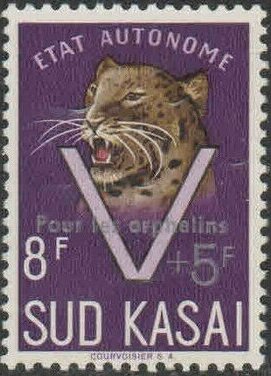Stamp: Leopard head overprint (South Kasai 1961)
Leopard head overprint (South Kasai 1961)
20 June (South Kasai ) within release Leopard’s head goes into circulation Stamp Leopard head overprint face value 8+5 Congolese franc
| Stamp Leopard head overprint in catalogues | |
|---|---|
| Belgium: | Bel: CD-SK 23A |
Stamp is vertical format.
overprint: Pour les orphelinsAlso in the issue Leopard’s head:
- Stamp - Leopard (Panthera pardus) face value 1;
- Stamp - Leopard (Panthera pardus) face value 1.50;
- Stamp - Leopard (Panthera pardus) face value 3.50;
- Stamp - Leopard (Panthera pardus) face value 8;
- Stamp - Leopard (Panthera pardus) face value 10;
- Stamp - Leopard head overprint face value 1+5;
- Stamp - Leopard head overprint face value 3.50+5;
- Stamp - Leopard head overprint face value 8+5;
- Stamp - Leopard head overprint face value 1.50+5;
- Stamp - Leopard head overprint face value 10+5;
Stamp Leopard head overprint it reflects the thematic directions:
Animals are multicellular, eukaryotic organisms of the kingdom Animalia (also called Metazoa). All animals are motile, meaning they can move spontaneously and independently, at some point in their lives. Their body plan eventually becomes fixed as they develop, although some undergo a process of metamorphosis later on in their lives. All animals are heterotrophs: they must ingest other organisms or their products for sustenance.
The fishing cat (Prionailurus viverrinus) is a medium-sized wild cat of South and Southeast Asia. It has a deep yellowish-grey fur with black lines and spots. Adults have a head-to-body length of 57 to 78 cm (22 to 31 in), with a 20 to 30 cm (7.9 to 11.8 in) long tail. Males are larger than females weighing 8 to 17 kg (18 to 37 lb); females average 5 to 9 kg (11 to 20 lb). Since 2016, it is listed as Vulnerable on the IUCN Red List. Fishing cat populations are threatened by destruction of wetlands and have declined severely over the last decade. The fishing cat lives foremost in the vicinity of wetlands, along rivers, streams, oxbow lakes, in swamps, and mangroves.
Mammals are any vertebrates within the class Mammalia (/məˈmeɪli.ə/ from Latin mamma "breast"), a clade of endothermic amniotes distinguished from reptiles (including birds) by the possession of a neocortex (a region of the brain), hair, three middle ear bones and mammary glands. All female mammals nurse their young with milk, secreted from the mammary glands. Mammals include the largest animals on the planet, the great whales. The basic body type is a terrestrial quadruped, but some mammals are adapted for life at sea, in the air, in trees, underground or on two legs. The largest group of mammals, the placentals, have a placenta, which enables the feeding of the fetus during gestation. Mammals range in size from the 30–40 mm (1.2–1.6 in) bumblebee bat to the 30-meter (98 ft) blue whale. With the exception of the five species of monotreme (egg-laying mammals), all modern mammals give birth to live young. Most mammals, including the six most species-rich orders, belong to the placental group. The largest orders are the rodents, bats and Soricomorpha (shrews and allies). The next three biggest orders, depending on the biological classification scheme used, are the Primates (apes and monkeys), the Cetartiodactyla (whales and even-toed ungulates), and the Carnivora (cats, dogs, seals, and allies).



